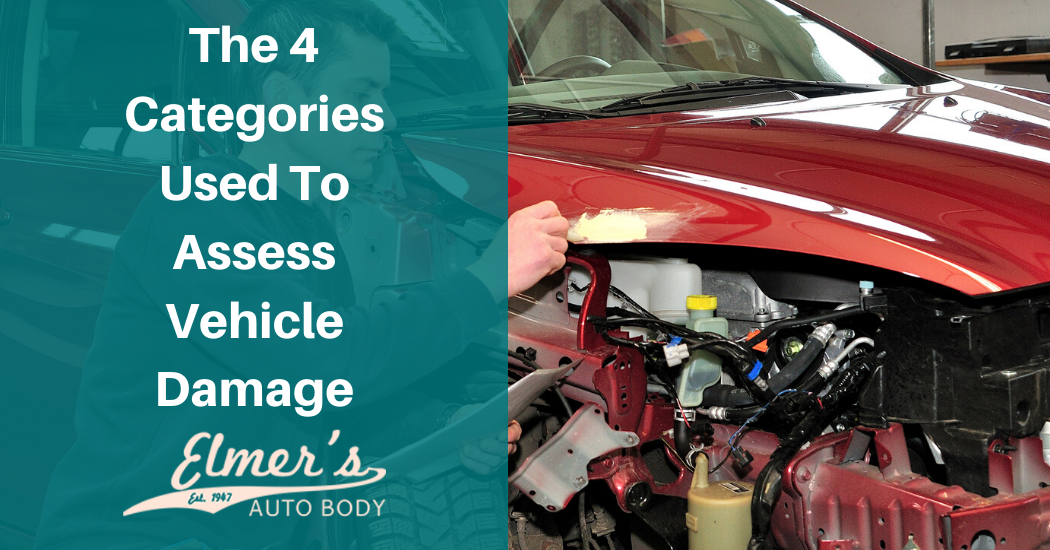A vehicle accident is one of those things that no one wants to consider.
When your car is involved in an accident, one of the first things you should do is to inform your insurance company. Of course, your first call should be a call to the police so that they can file a report, but the insurance company is your next priority. They will probably send an inspector to your home in short order to evaluate your vehicle. This article is intended to help you understand the terms that the inspector will likely use.
The Four Categories Used To Assess Vehicle Damage
Based on the level of damage, an insurance assessor will classify your vehicle into one of four categories. We should note that these categories have changed in recent years. In the past, vehicle damage was classified into categories A, B, C, or D. This system worked pretty well, but it had one flaw: It was based only on the estimated monetary cost of the damage. The new ratings take cost into account, but they focus more on safety concerns.
It is crucial to understand the legal aspects when dealing with an insurance claim. Anytime an accident occurs, your insurance company (and the authorities) will want to determine who was at fault. That will determine who pays for the majority of the damages. Without an inspection, there is no way to know what kind of insurance claim to file.
Category A: Completely Ruined
This category represents the worst kind of damage and indicates that the car cannot be repaired. A vehicle in this category cannot be driven again, and its parts cannot be removed and re-sold. When this level of damage occurs, the only thing you can do is send it to the scrapyard and collect whatever you can.
Category B: Only Good For Parts
A car in this category has suffered severe damage, and can never be driven again. However, it is permitted to salvage any undamaged parts for re-sale. The salvage yard will scrap all of the damaged parts. Most of the time, the insurance company will not permit you to salvage any part of the vehicle’s body. Cars in this category have usually suffered extensive body damage.
Category S: Major Damage
You could describe this level of damage as “bad, but repairable.” A vehicle in category S has sustained severe structural damage. The letter “S” indicates this fact. As such, the frame is probably no good, and the body is also likely not salvageable. However, it might be possible to salvage the frame if you take your vehicle to a skilled professional. You must take vehicles in this category to a licensed mechanic for extensive repairs, and you cannot drive the vehicle until repairs are complete.
Category N: Minor Damage
This category is the one that you want to hear when the inspector comes around. Category N damage might be as light as a busted headlight or a broken wire. As such, you might be able to repair this damage without taking it to an expensive body shop. Since these cars have no body or frame damage, you will only have to swap the damaged parts with undamaged parts. These vehicles might be safe to drive in the meantime, but you shouldn’t take any chances. If the car has any damage to the brake system, turn signals, transaxles, or transmission, you shouldn’t drive it until its repaired.
Buying A Damaged Car
Sometimes, you can buy damaged cars at a very low price. Of course, you need to have some basic auto repair skills (or maybe a little more than that, depending on the level of damage). Even those with no auto repair expertise, you might be able to turn a profit by re-selling a car after completed repairs.
If this is your intention, it is vitally important that you familiarize yourself with the damage categories listed above. In this way, you can make sure that you get a vehicle that isn’t beyond your ability to save. You can also make sure that the seller has been honest with you by doing a vehicle history check. If you don’t know how to do that, you will be relieved to hear that it’s quite easy. All you have to do is get the VIN from the seller (before you pay, of course!). The VIN is just a unique identifying number that allows you to check the vehicle’s history. Once you have it, search the number on this website. Some companies will try to get you to pay for this service, but it can be done for free if you know where to look.
Conclusion
Thankfully, this system is not complicated or difficult to learn. After reading this short article, you should at least be able to understand the terms in which your insurance provider will describe the damage. For most people, that’s all that is necessary.
When it comes to legal questions, we recommend that you contact your attorney as soon as you have finished dealing with the police and the insurance company. We hope that we have been helpful to you and that you will fill out the contact form below for more information.

